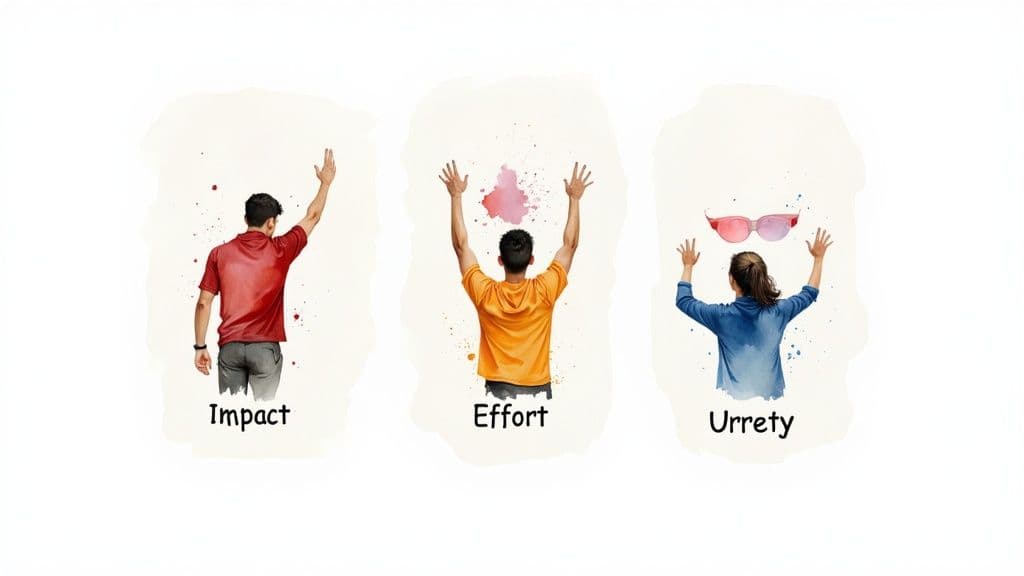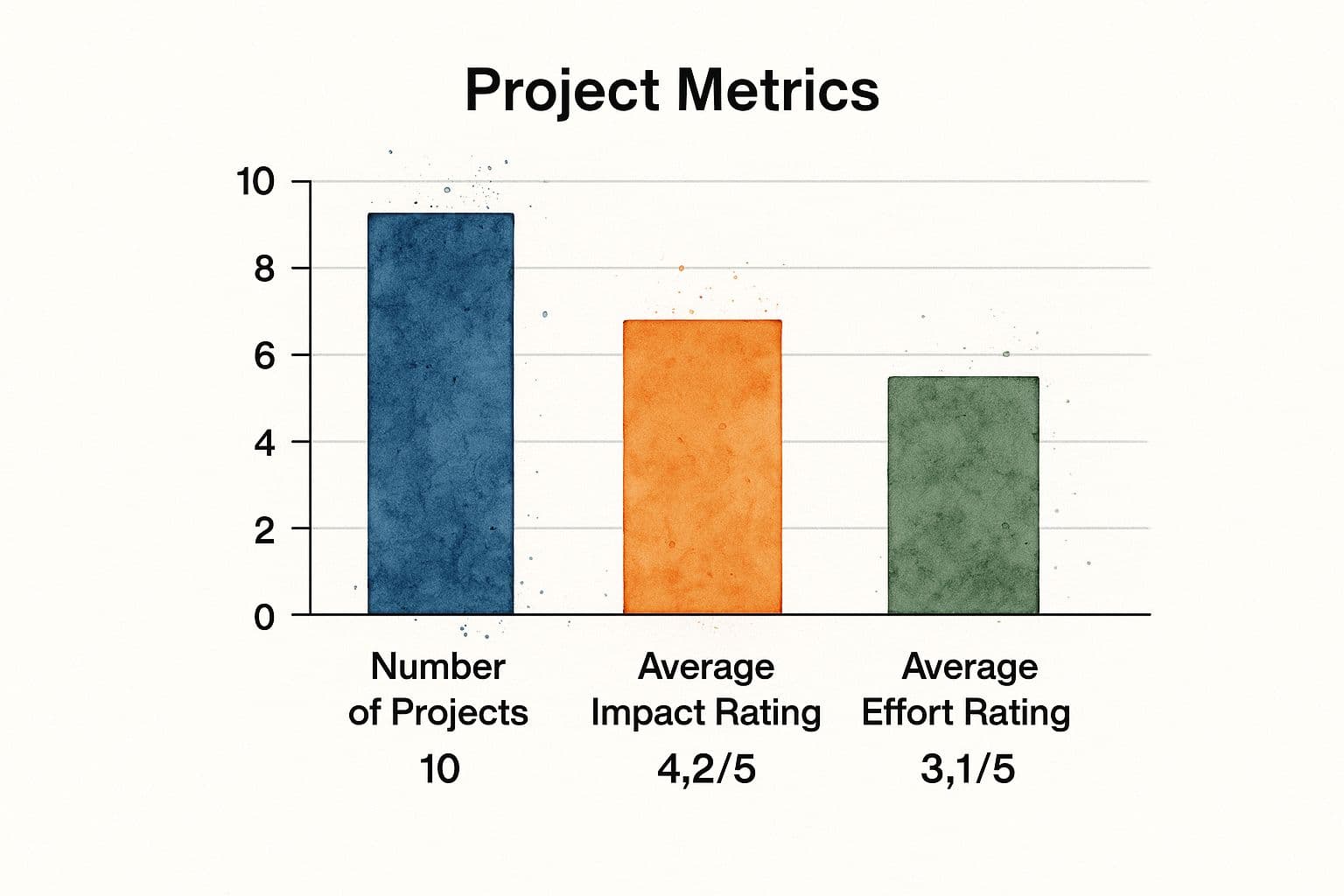Use our free project priority matrix template to prioritize tasks, reduce decision fatigue, and keep teams focused on what matters most. Download now and start aligning work with strategic goals.
June 5, 2025 (6mo ago) — last updated December 11, 2025 (4d ago)
Free Project Priority Matrix Template
Download a free project priority matrix template to prioritize tasks, align teams, and boost project efficiency with Eisenhower and weighted scoring methods.
← Back to blog
Title: Free Project Priority Matrix Template
Summary: Download a free project priority matrix template to prioritize tasks, align teams, and boost project efficiency with Eisenhower and weighted scoring methods.
Introduction: Use our free project priority matrix template to prioritize tasks, reduce decision fatigue, and keep teams focused on what matters most. Download now and start aligning work with strategic goals.
Why Every Team Needs a Priority Matrix Template (And How To Choose Yours)
Project chaos is a familiar challenge. Most teams feel overwhelmed by competing priorities, which often pushes important work to the back burner. Project priority matrix templates help teams move from reactive firefighting to proactive, strategic execution. These visual tools simplify complex decisions, reduce cognitive overload, and make it easier to focus on outcomes.
A priority matrix aligns prioritization with how people actually make decisions. Visual cues and clear criteria speed up choices and free up mental capacity for doing the work. Many organizations use matrix templates within broader quality and process frameworks to improve workflow and outcomes1.
The right template depends on your team’s size, project complexity, and decision criteria. Small teams may prefer a simple Eisenhower Matrix for daily tasks, while larger teams handling multi-stakeholder projects often need weighted scoring models to balance many criteria.
Choosing the Right Template
- Eisenhower Matrix: Best for quick decisions based on urgency and importance. Great for individual or small-team daily planning.
- Impact vs. Effort Matrix: Helps spot low-effort, high-impact opportunities and avoid resource-heavy, low-return work.
- Weighted Scoring Matrix: Ideal for complex, strategic decisions where multiple criteria must be balanced with explicit weights.
Selecting the right project priority matrix template gives teams structure for making trade-offs and allocating resources more effectively. For practical guides on prioritization, see our posts on how to prioritize work effectively and customer alignment with a customer journey mapping template.
Mastering the Eisenhower Matrix Template That Actually Works

The Eisenhower Matrix divides work into four quadrants: urgent and important, important but not urgent, urgent but not important, and neither urgent nor important. Many teams struggle to apply it correctly because urgency often masquerades as importance. The difference is key: urgent tasks demand immediate attention, while important tasks drive long-term goals.
Train your team to ask, “How does this task advance our objectives?” and to revisit priorities regularly. Consider numeric scoring for urgency and importance to reduce subjectivity, or add an “effort” dimension when decisions need more nuance.
Advanced Variations and Customization
- Use numerical scores for urgency and importance to create objective thresholds.
- Add an “effort” or “risk” axis for richer decisions in product or engineering contexts.
- Iterate the template based on retrospective learnings so it stays practical and relevant.
Avoid priority inflation by defining clear criteria for each quadrant and applying them consistently across the team.
Building Weighted Scoring Templates for Complex Project Decisions

Weighted scoring templates let teams evaluate options across multiple criteria, each with a defined weight. Start by listing criteria that map to strategic goals—examples include technical feasibility, user value, cost, and regulatory risk. Assign weights that reflect relative importance and score each option against those criteria.
Weighted decision matrices support transparency and data-driven prioritization, and many teams report clearer alignment between projects and strategy after adopting them2.
Stakeholder Involvement and Usability
Invite stakeholders into the weighting process through structured workshops or surveys. Limit the number of criteria to avoid analysis paralysis—focus on the most influential factors and refine weights using real outcomes rather than assumptions.
Digital Tools That Transform Your Priority Matrix Experience
Static spreadsheets can work, but digital tools add collaboration, automated scoring, and integrations that keep prioritization current and visible. Features to look for include real-time collaboration, automated scoring, and easy integrations with your project management stack.

Popular tools vary by focus and complexity. Tools like Airtable, Monday.com, ClickUp, Asana, and Trello each offer different strengths in template flexibility, visualization, and collaboration. Choose a tool that matches your team’s technical comfort and the level of structure you need4.
Digital templates can reduce meeting time, centralize stakeholder input, and make prioritization part of daily workflows. Vendors’ case studies describe faster decisions and better alignment after adopting digital prioritization workflows5.
Industry-Specific Templates That Address Real-World Challenges
Different industries require different criteria. Here are common adaptations:
- Software development: Add criteria for technical debt, long-term maintainability, and user value to avoid short-term decisions that harm long-term velocity.
- Healthcare: Include patient impact, regulatory risk, and ethical considerations to balance outcomes and compliance.
- Construction: Account for weather sensitivity, resource dependencies, and permitting timelines to improve scheduling accuracy.
Adapting templates to industry realities produces measurable improvements. For example, teams that explicitly score technical debt report quicker reductions in recurring issues and better long-term stability.
Implementation Strategies That Actually Stick
A template’s value depends on consistent use. Successful rollout combines training, governance, and measurement.
Initial Training and Buy-In
Run hands-on workshops, walk the team through sample prioritizations, and make expectations clear. Practical exercises boost confidence and help secure buy-in.
Productive Prioritization Discussions
Use structured facilitation techniques—dot voting, time-boxed scoring sessions, and clear decision rules—to keep conversations focused and aligned with strategic goals.
Accountability and Measurement
Integrate the matrix into regular meetings, assign ownership for maintenance, and track metrics like on-time delivery and budget adherence. Measure outcomes and iterate the template to keep it effective.
Implementation Timeline (Example)
| Phase | Duration | Key Activities | Success Metrics |
|---|---|---|---|
| Introduction and Training | 1–2 weeks | Workshops, hands-on practice | Team understands how to use the matrix |
| Initial Implementation | 2–4 weeks | Apply matrix to live projects | Improved prioritization decisions |
| Review and Refinement | Ongoing | Regular reviews, data analysis | Consistent use, measurable improvements |
| Integration and Automation | Ongoing | Tool integrations, automated reporting | Reduced admin overhead |
Key Takeaways
- Choose the simplest template that meets your needs and scale up when decisions grow more complex.
- Use weighted scoring for multi-criteria, multi-stakeholder decisions and Eisenhower for quick daily prioritization.
- Train teams, set clear criteria, and measure outcomes so prioritization remains a reliable decision-making foundation.
Ready to streamline workflows and improve project management? Visit Fluidwave to explore AI-driven task management and templates.
Q&A
Q: Which matrix should my small team use? A: Start with the Eisenhower Matrix for daily task clarity, then introduce scoring if decisions become frequent or contentious.
Q: How do I prevent every task from being labeled “urgent and important”? A: Define clear, shared criteria for each quadrant and use numeric scoring or examples to keep assessments consistent.
Q: How can I involve stakeholders without slowing decisions? A: Use short workshops or surveys to gather input, then consolidate weights and run a final prioritization session with clear decision rules.
Focus on What Matters.
Experience lightning-fast task management with AI-powered workflows. Our automation helps busy professionals save 4+ hours weekly.